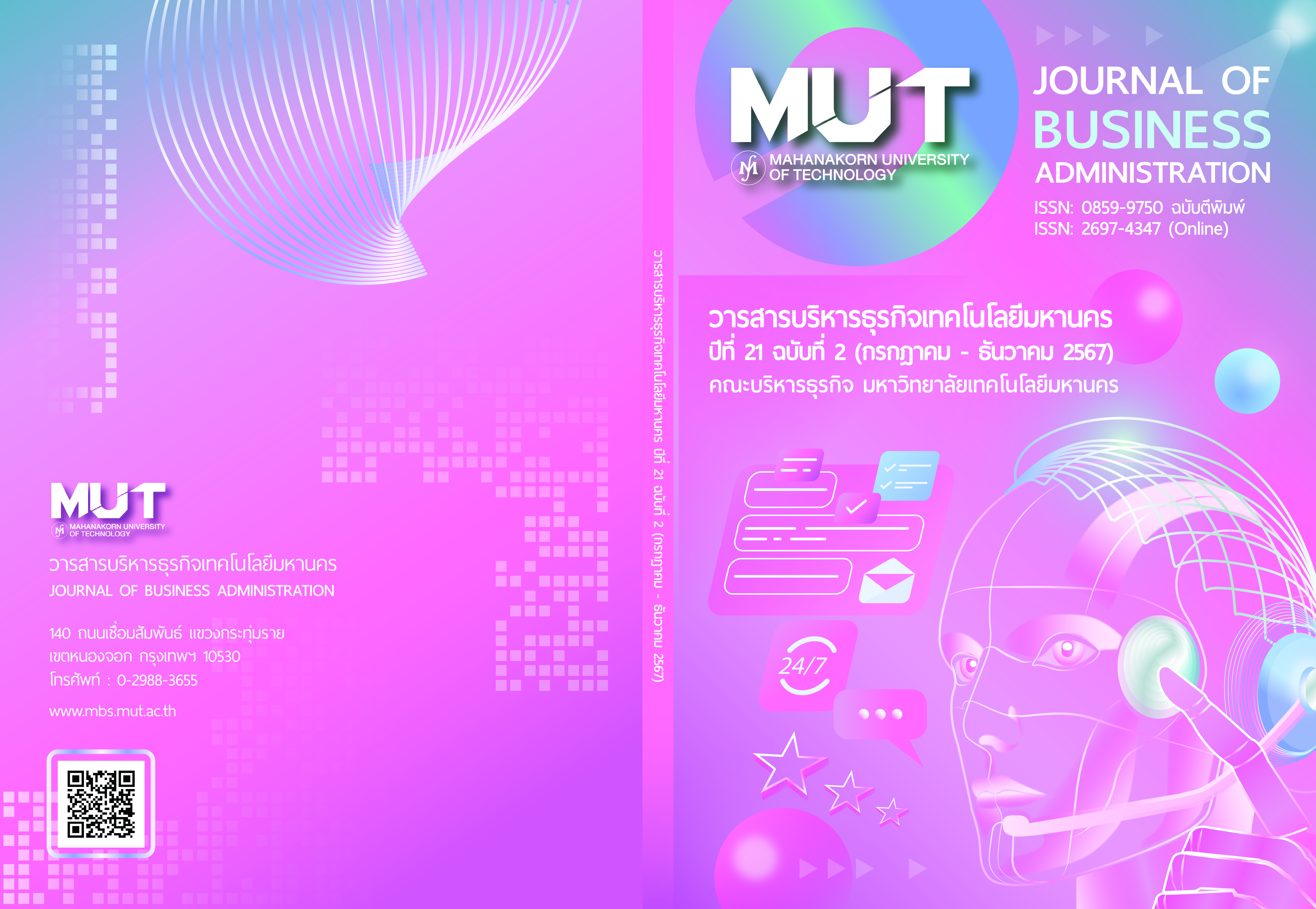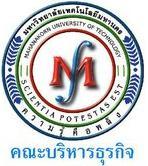The Influence of Service Quality on the Performance of Food and Beverage Businesses in Thailand
Keywords:
Service Quality, Culture, Customer Satisfaction, Service performanceAbstract
This research employed a mixed-method approach to study the service quality and performance of restaurants and beverage shops. The main objective was to study the relationship between service quality and organizational performance of restaurants and beverage shops. The data collection tools included questionnaires to gather quantitative data on customers’ perspectives and interviews to collect qualitative data on the attitudes of restaurant and beverage shop operators in 5 provinces: 1) Sangkhla Buri, Kanchanaburi Province, 2) Suan Phueng, Ratchaburi Province, 3) Yala Province, 4) Pattani Province, and 5) Narathiwat Province. The convenience sampling method was used to select 432 customers and 14 restaurants and beverage shops offering dine-in, street food, and delivery services, in order to measure service quality from the perspective of customers with different cultural dimensions. The objectives were: 1) to study the components of restaurant service quality from the perspective of customers with different cultural dimensions, 2) to study the characteristics of customers’ cultural dimensions that influence their expectations of service quality, and 3) to study the influence of service quality on organizational performance. The data collected from the questionnaires were analyzed using descriptive statistics, including percentage, mean, and standard deviation, with the Amos software to process the statistical data for the Structural Equation Model (SEM). Various indices such as the Chi-square index, Goodness of Fit Index (GFI), Adjusted Goodness of Fit Index (AGFI), Tucker Lewis Index (TLI), Incremental Fit Index (IFI), Comparative Fit Index (CFI), and Root Mean Square Error of Approximation (RMSEA), were used to analyze the regression coefficients of the variables.
The research results indicated that: 1) Service quality, as perceived by customers, comprised three components: tangible (Concrete Element), ability to support customers (Ability to Serve), and compassion in service (Service Caring). 2) The characteristics of the customer’s cultural dimensions in terms of power distance, risk avoidance, and long-term perspectives influenced service quality expectations. These service quality expectations, in turn, affected both the perceived and customer satisfaction. Moreover, the perceived service quality and customer satisfaction impacted organizational performance. 3) The qualitative data revealed that the stores prioritized service quality components differently than customers, with the highest emphasis on Ability to Serve, followed by Service Caring and Concrete Element. 4) Fit indices values from statistical analysis using the Amos program were CMIN/df = 3.243, Goodness of Fit Index (GFI) = 0.884, Adjusted Goodness of Fit (AGFI) = 0.851, Tucker Lewis Index (TLI) = 0.905, Incremental Fit Index (IFI) = 0.921, Comparative Fit Index (CFI) = 0.920, Root Mean Square Error of Approximation (RMSEA) = 0.072.
References
Ahrholdt, D. C., Gudergan S.P. and Ringle, C.M. 2016. Enhancing Service Loyalty: The Roles of Delight, Satisfaction, and Service Quality. Retrieved March 30, 2024 from https://journals. sagepub.com/doi/10.1177/0047287516649058
Ali, F., Hussain, K., Konar, R. and Jeon, H. 2016. The Effect of Technical and Functional Quality on Guests’ Perceived Hotel Service Quality and Satisfaction: A SEM-PLS Analysis. Journal of Quality Assurance in Hospitality and Tourism. Vol. 18. No. 3. 354 - 378.
Austin, D.M. and Gagné, P. 2008. Community in a mobile subculture: the world of the touring motorcyclist. Studies in Symbolic Interaction. Vol. 30. 411 - 437.
Barney, J. B. 1986. Organizational Culture: Can It Be a Source of Sustained Competitive Advantage? The Academy of Management Review. Vol. 11. No. 3. 656 - 665.
Baumgartner, H. and Homburg, C. 1996. Applications of structural equation modeling in marketing and consumer research: A review. International journal of research in marketing. Vol. 13. Issue. 2. 139–161.
Baxter, V. K. and Marina, P. 2008. Cultural meaning and hip-hop fashion in the African-American male youth subculture of New Orleans. Journal of Youth Studies. Vol. 11. No. 2. 93 - 113.
Boonlertvanich, K. 2011. Effect of Customer Perceived Value on Satisfaction And Customer Loyalty In Banking Service: The Moderating Effect Of Main-Bank Status. International Journal of Business Research. Vol. 11. No. 6. 40 - 55.
Bougoure, U.S. and Neu, M.K. 2010. Service Quality in the Malaysian Fast Food Industry: An Examination Using DINESERV. Services Marketing Quarterly. Vol. 31. No2. 194 - 212.
Browne, M. W. and Cudeck, R. 1992. Alternative ways of assessing model fit. Sociological Methods & Research. Vol. 21. 230 – 258.
Cronin, J. J. and Taylor, S. A. 1992. Measuring Service Quality: A Reexamination and Extension. Journal of Marketing. Vol. 56. No. 3. 55 - 68.
Das, D., Chawla, U. and Ray, S. 2017. Factors Affecting Customer Satisfaction and Service Quality in the Boutique Hotel Industry of Kolkata, West Bengal. International Journal of Management. Vol. 8. No. 6. 130 - 135.
De Mooij, M. and Hofstede, G. 2011. Cross-Cultural Consumer Behavior: A Review of Research Findings. Journal of International Consumer Marketing. Vol. 23. 181 – 192.
Díaz, E., Gómez, M., Martín-Consuegra, D. and Molina, A. 2017. The Effects of Perceived Satisfaction with Service Recovery Efforts: A Study in A Hotel Setting. Marketing and Trade. Vol. 4. 203 - 218.
Doll, W. J., Xia, W. and G. Torkzadeh. 1994. Aconfirmatory Factor Analysis of End-User Computing Satisfaction Instrument. MIS Quaterly. 453 - 461.
Economics Tourism and Sports Division. 2020. Statistics of tourists traveling to Thailand. Retrieved March 29, 2024 from https://www.mots.go.th/news/category/592
Fornell, C., Johnson, M. D., Anderson, E. W., Cha, J. and Everitt Bryant, B. 1996. The American Customer Satisfaction Index: Nature, Purpose, and Findings. Journal of Marketing. Vol. 60. No. 4. 7 - 18.
Gayatri, G., Hume, M. and Mort, G. S. 2011. The role of Islamic culture in service quality research. Asian Journal on Quality. Vol. 12. No. 1. 35 - 53.
Gefen, D., Straub, D. and Boudreau, M. 2000. Structural Equation Modeling and Regression: Guidelines for Research Practice. Communications of the Association for Information Systems. Vol. 4
Gordon, M. 1947. The Concept of the Sub-Culture and Its Application. Social Forces. Vol. 26. No. 1. 40 - 42.
Hair, J. F., Jr., Anderson, R. E., Tatham, R. L. and Black, W. C. 2006. Multivariate data analysis. 6th Ed. Upper Saddle River, NJ: Prentice Hall.
Hofstede, G. 1991. Cultures and Organizations: Software of the Mind. London: McGraw-Hill UK.
Hofstede, G. 2009. Dimensionalizing Cultures: The Hofstede Model in Context. Online Readings in Psychology and Culture, Unit 2. Retrieved March 28, 2024 from http://scholarworks.gvsu.edu/orpc/vol2/iss1/8
Hofstede, G., Hofstede, G. J. and Minkov, M. 2010. Cultures and Organizations: Software of the Mind. Revised and Expanded. 3rd Ed. New York: McGraw Hill.
Huang, S. and Crotts, J. 2019. Relationships between Hofstede's Cultural Dimensions and Tourist Satisfaction: A Cross-country Cross-sample Examination. Tourism Management. Vol. 72. 232 - 241.
Kang, D.S. and Mastin, T. 2008. How Cultural Difference Affects International Tourism Public Relations Websites: A Comparative Analysis Using Hofstede's Cultural Dimensions. Public Relations Review. Vol. 34. No. 1. 54 - 56.
Kasiri, L.A., Cheng, K., Sambasivan, M. and Sidin, S.M. 2017. Integration of Standardization and Customization: Impact on Service Quality, Customer Satisfaction, and Loyalty. Journal of Retailing and Consumer Services. Vol. 35. 91 - 97.
Kim, H. J., McCahon, C. and Miller, J. 2003. Assessing Service Quality in Korean Casual-Dining Restaurants Using DINESERV. Journal of Food Service Business Research. Vol. 6. No. 1. 67 - 86.
Kueh, K. and Voon, B. H. 2007. Culture and service quality expectations: Evidence from Generation Y consumers in Malaysia. Managing Service Quality. Vol. 17. No. 6. 656 - 680.
Laroche, M., Ueltschy, L. C., Abe, S., Cleveland, M. and Yannopoulos, P.P. 2004. Service Quality Perceptions and Customer Satisfaction: Evaluating the Role of Culture. Journal of International Marketing. Vol. 12. No. 3. 58 – 85.
Lee, S.M.and Peterson, S.J.2000.Culture, Entrepreneurial Orientation, and Global Competitiveness. Journal of World Business. Vol. 35. No. 4. 401 - 416.
Maffesoli, M. 1996. The Time of the Tribes: The Decline of Individualism in Mass Society. London: Sage UK.
McPherson, M., Smith-Lovin, L. and Brashears, M. E. 2006. Social Isolation in America: Changes in Core Discussion Networks over Two Decades. American Sociological Review. Vol. 71. No. 3. 353 – 375.
Meesala, A. and Paul, J. 2018. Service Quality, Consumer Satisfaction and Loyalty in Hospitals: Thinking for the Future. Journal of Retailing and Consumer Services. Vol. 40. 261 - 269.
Minh N.V. and Huu N.H. 2016. The Relationship between Service Quality, Customer Satisfaction and Customer Loyalty: An Investigation in Vietnamese Retail Banking Sector. Journal of Competitiveness. Vol. 8. No. 2. 103 - 116.
Ngo Vu Minh and Nguyen Huan. 2016. The Relationship between Service Quality, Customer Satisfaction and Customer Loyalty: An Investigation in Vietnamese Retail Banking Sector. Journal of Competitiveness. Vol. 8. No. 2. 103 - 116
Nunnally, J. C. and Bernstein, I. H. 1994. Psychometric Theory. 3rd Ed. New York: McGraw-Hill USA.
Oliver, R. L. 1980. A Cognitive Model of the Antecedents and Consequences of Satisfaction Decisions. Journal of Marketing Research. Vol. 17. 460 - 469.
Oliver, R. L. 2015. Satisfaction: A Behavioral Perspective on the Consumer. 2nd Edition. Routledge. Oxford, UK.
Parasuraman A., Zeithaml, V.A. and Berry, L. L. 1985. A Conceptual Model of Service Quality and its Implications for Future Research. Journal of Marketing. Vol. 49. 41 - 50.
Parasuraman, A., Zeithaml, V. A. and Berry, L. L. 1988. Servqual: A Multiple-Item Scale For Measuring Consumer Perceptions of Service Quality. Journal of Retailing; Greenwich Vol. 64. Issue. 1. 12.
Prasongsukarn, K. 2009. Validating the Cultural Value Scale (CVSCALE): A Case Study of Thailand. ABAC Journal. Vol. 29. No. 2. 1 - 13
Priporas, C.V., Stylos, N. and Vedanthachari, L.N. 2017. Service Quality, Satisfaction and Customer Loyalty in Airbnb Accommodation in Thailand. International Journal of Tourism Research. Vol. 19. No. 6. 693 - 704.
Raitanen, J. and Oksanen, A. 2018. Global Online Subculture Surrounding School Shootings. American Behavioral Scientist. Vol. 62. No. 2. 195 - 209.
Schein, E. H. 1988. Organizational Culture. Working paper (Sloan School of Management). Vol. 2088. 88.
Schein, E. H. 1990. Organizational Culture. American Psychology. Vol. 45. No. 2. 109 - 119.
Schermelleh-Engel, K. and Moosbrugger, H. 2003. Evaluating the Fit of Structural Equation Models: Tests of Significance and Descriptive Goodness-of-Fit Measures. MPR-Online. Vol. 8. No. 2. 23 – 74
Stroope, S. and Tom, J. C. 2017. In-home firearm access among US adolescents and the role of religious subculture: Results from a nationally representative study. Social Science Research. Vol. 67. 147 - 159.
Trade Policy and Strategy Office. 2023. Food and Beverage Business Situation in Thailand: Challenges and Adaptations for Food and Beverage Business Survival. 2023. Office of Trade Policy and Strategy (OTPS). Ministry of Commerce. 1 - 6.
Yamane, T. 1973. Statistic: An introductory and lysis. 2nd Ed. New York: Harpar and row.
Yoo, B., Donthu, N. and Lenartowicz, T. 2011. Measuring Hofstede's Five Dimensions of Cultural Values at the Individual Level: Development and Validation of CVSCALE. Journal of International Consumer Marketing. Vol. 23. No. 3-4. 193 - 210.
Zeithaml, V. A, Berry, L. L. and Parasuraman, A. 1988. Communication and Control Processs in Delivery of Service Quality. Journal of Marketing. Vol. 52. 35 - 48.
Additional Files
Published
Issue
Section
License

This work is licensed under a Creative Commons Attribution-NonCommercial-NoDerivatives 4.0 International License.
ข้อความ ข้อคิดเห็น ข้อมูล เนื้อหา รูปภาพ แผนภูมิ แผนผัง เป็นต้น ที่ปรากฏและแสดงในบทความต่างๆ ในวารสารบริหารธุรกิจเทคโนโลยีมหานคร ถือเป็นความรับผิดชอบโดยตรงของผู้เขียนบทความนั้นๆ มิใช่เป็นความรับผิดชอบใดๆ ของวารสารบริหารธุรกิจเทคโนโลยีมหานคร และมหาวิทยาลัยเทคโนโลยีมหานคร
บทความที่ตีพิมพ์ในวารสารบริหารธุรกิจเทคโนโลยีมหานคร ถือเป็นลิขสิทธิ์เฉพาะของคณะบริหารธุรกิจ มหาวิทยาลัยเทคโนโลยีมหานคร หากบุคคลหรือหน่วยงานใดต้องการนำทั้งหมดหรือส่วนใดส่วนหนึ่งไปเผยแพร่ต่อหรือเพื่อกระทำการใดๆ จะต้องได้รับการอนุญาตเป็นลายลักษณ์อักษรจากคณะบริหารธุรกิจ มหาวิทยาลัยเทคโนโลยีมหานครก่อนเท่านั้น


